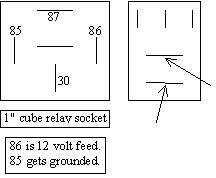OH! I get it. I do not think the two things are related, but we should not discount that possibility totally. I have the same ignition switch in many of my vehicles, including the one I am sitting in right now. It has a common problem of one set of contacts becoming overheated, and that heat migrates out to the connector terminals and causes them to overheat. This can work the other way too. One of those terminals can overheat and that heat migrates into the switch and overheats the contacts. This happens most often to people who use the heater fan on the highest speed a lot, and turn the ignition switch on or off while leaving the fan switch on "high".
Look at your old switch to see if two adjacent terminals are black or discolored. If they are, the fix is to replace the switch, and those two terminals must be cut out of the connector body, (that is usually melted too), then the first four inches of those wires must be cut away. They will be hard from being overheated, and solder won't adhere to them. Splice in four inches of new wire of the same diameter, then crimp on two universal terminals. Solder them too, then plug them in individually. Only use heat-shrink tubing to seal the splices. Electrical tape will unravel into a gooey mess on a hot day.
This circuit feeds the heater fan, power windows, and radio. A clue to look for, if you have power windows and a cassette player in the radio, is the cassette mechanism may kick out when both power windows bottom out at the same time. The stalled window motors will draw higher current when they stop running. That higher current causes a bigger drop in voltage across the ignition switch, and the radio incorrectly interprets that as the ignition switch was turned off. In response, it kicks out the cassette player so the pinch rollers do not get a flat spot. The cassette player will kick in again when you release the window switches.
That heater fan/window part of the ignition switch is not part of the ignition system or starter system, so with those two overheated terminals, the engine will still run and the starter will still work. That does not mean there cannot be something else wrong with the ignition switch. The problem I just described is just the most common one.
For the starter system, you're way ahead of what most people would have been able to figure out. Jumping thirty and eighty seven jumps the contacts, and the starter cranked, as expected. Applying ground and twelve volts to the relay's coil proved the relay was okay. Now, you should be able to apply just one of them to see which circuit has the problem, but here is a different way to approach this that works with any starter relay. The relay splits the system into four distinct parts. You can test each part on one of those terminals with the relay removed.
As a side note, these tests are best done with an inexpensive test light. You can use a digital voltmeter, but they can give false indications with this type of problem. If there is a carbon track across a break in a wire, or just a single strand of wire remaining and the rest are corroded away, that is enough for a voltmeter to show voltage is there, but a test light needs current to operate, and you will not get enough current through those breaks. The test light will show the correct test result.
One terminal in the relay's socket will have twelve volts all the time. In your case, that is terminal thirty. Another will have twelve volts only when a helper turns the ignition switch to the "crank" position. That's terminal eighty six.
Now move the test light's ground clip to the battery's positive post so we can test for a good ground circuit. Probe the two remaining terminals, and the test light should light up. The middle terminal on Chrysler relays is not used. Terminal eighty seven goes to the starter solenoid, then to ground. We know that circuit is okay because you had it cranking from the relay. Terminal eighty five is the ground for the relay's coil, but that is the circuit where Chrysler puts the neutral safety switch. Some manufacturers, including GM, put the neutral safety switch in the circuit coming from the ignition switch.
You are gong to find one of those two circuits is not working, and we already know thirty and eighty seven are okay. That leaves eighty five or eighty six as not working.
Next, your truck still uses the common sense neutral safety switch that Chrysler used since the early 1960's. It has three wires. The two outer wires get connected together to turn on the back-up lights. The middle wire gets grounded in "park" and "neutral" to ground the starter relay's coil. If I was a betting boy, my bet is for the neutral safety switch. Next would be someone had the plug off, and it did not get put back on tight.
Image (Click to make bigger)
Friday, June 23rd, 2017 AT 4:22 PM



